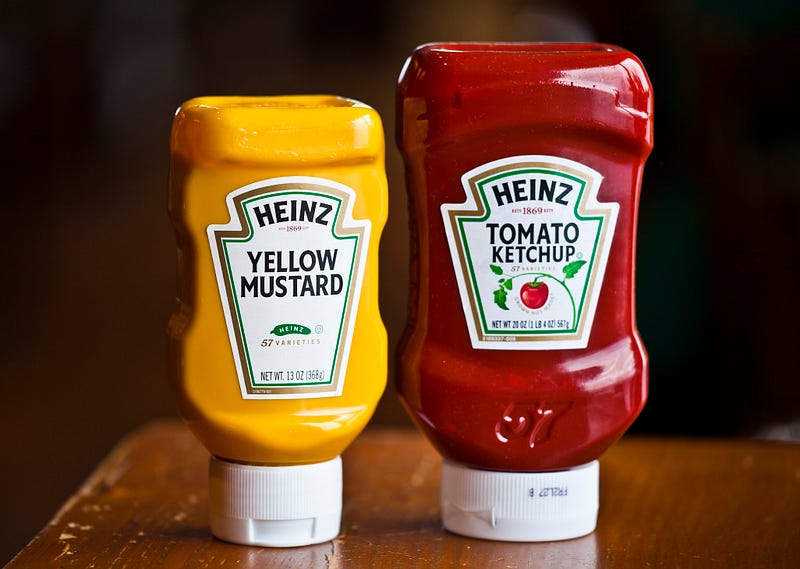Once, when meeting with the CEO of a new customer, I pulled out a bottle of ketchup and set it on the table.
It was one of these …

It was the centerpiece of an argument I was about to make:
Our product is perfect.
Don’t try to change it.
It had taken me years to have the gumption to make this claim, but this was the right time to do so.
We had spent countless years enduring innumerable pressures to customize our solution when we believed our feature set already offered everything our customers needed.
All the extra bells and whistles they forced us to add were superfluous and degraded the product.
Don’t get me wrong, we had some gaps — as many young product companies do — but nothing a little patience couldn’t fix.
Our weakness in making a case against customization led to elongated, expensive implementations.
It had gotten so bad, we quickly became known as the best and the most expensive solution in the market.
It was painful, and I wanted it to stop.
This new customer presented me with the opportunity to do so.
So, I channeled ketchup.
Wait, ketchup?
(I know what you are thinking.)
To understand why, I will enlist my favorite author, Malcolm Gladwell.
Several years ago, Malcolm wrote a timeless, deep-dive piece for The New Yorker magazine called The Ketchup Conundrum.
He was trying to answer a good question, “why is Heinz still the king of ketchup?”
It’s true.
Today, Heinz (one of seven notable brands) still dominates the global ketchup market with an 80% percent market share in Europe and a 60% market share in the US. In fact, over 10 billion ounces of ketchup consumed annually — that’s nearly three bottles per person.
In other words, why has no Grey Poupon — the disruptive player in the mustard industry that converted people in droves from good old fashioned yellow mustard to magical dijon in the 70s — emerged in the ketchup industry?
The answer: Heinz has built such a perfect product, there is no need for a replacement.
Henry J. Heinz developed the first chemical-free version of the winning recipe using ripe, red tomatoes — rich in natural preservatives. By the 1960s, the Heinz company leveraged emerging food science to create a formula that nailed ketchup.
The key is a perfect combination of ingredients that deliver a perfect balance of all the primal senses in your mouth — salt, sour, sweet, bitter, and umami (think the taste of meat).
(Actually, there is more to the story. It turns out that Heinz is the only exception of a principle called “Horizontal Segmentation.” It’s a phenomenon discovered by Howard Moskowitz, the extraordinary psycho-physicist, who’s had a lasting impact on the food industry. See the Rabbit hole section below.)
No other ketchup has this perfected. So, Heinz remains king.
The Ketchup Conundrum article struck a chord with me. It was my inspiration for this stunt.
Now back to the meeting with the CEO…
It took place just after a scorching July 4th weekend — one where everyone, including him, had most likely enjoyed a barbecue with their family and friends.
I said, “you ever wonder why there are so many versions of tomato sauce, but only one ketchup?”
He gave me a perplexed look.
Without missing a beat, I continued to explain that Heinz ketchup had created the perfect combination of flavors.
I listed each flavor and related it to our core product features.
(We used to call our product features the “five fingers.” Not the “five deadly venoms.” OK, dating myself.)
“Other products have too much acidity or too much sweetness, and therefore never took hold,” I said at one point.
“The point is Heinz ketchup is king because they don’t mess with the recipe. It’s perfect!
And so is my product,” I boldly declared.
His eyes lit up.
“It is the perfect complement to your systems, your teams, your company,” I said more or less.
“So please don’t change it. Because it will cost you!”
It was a ballsy move.
It worked.
The rollout for this customer was within budget and was a successful example of the virtues of using our product the way it came “out-of-the-box.”
“The ketchup guy was right,” he apparently noted to his CIO on launch day.
(Btw, I was forever known as the “ketchup guy” by the CEO. “Where is the ketchup guy?” “How is the ketchup guy?” The CIO brought a bottle of ketchup to our annual user conference to explain how to plan a successful implementation.)
Getting to product-market-fit takes time. It requires a close relationship with your customers, carefully learning their pains, and crafting the right recipe to meet their needs.
Countless companies achieve this perfect combination only to be duped by “the biggest deal ever” to change that recipe.
When this happens to you, remember ketchup. Remember Heinz.
The Ketchup Rabbit Hole
New Entrant: Sir. Kensington’s
Heinz and Grey Poupon have since found some up and coming revivals. One such product is Sir. Kensington — a New York-based condiment maker. The product-market-fit through countless tests and are not going back. They were acquired by Unilever in 2017.
For the founding story, I enjoyed this interview by Jessica Harris on her podcast From Scratch.
Howard Moskowitz
Do you ever wonder why there are so many types of spaghetti sauce (plain, meatball, zesty, spicy, extra chunky, cheese, light, rich and hardy, extra chunky garden, and so on)?
Howard Moskowitz, the famous American market researcher, and psychophysicist studied this in-depth. Moskowitz invented the concept of horizontal segmentation: the key to satisfying consumers is providing a sufficient number of distinct choices. “There is no perfect cola or perfect spaghetti sauce,” Moskowitz would say. “There are only perfect colas and perfect spaghetti sauces.” There is no perfect product, only different types of products for different kinds of people (and their preferences). Horizontal segmentation also means that if you ask people what they want, there is tremendous variability in their answers. The truth is they don’t know what they want. But, give them an array of choices, and you’ll notice groupings of exact preferences (hence, the many different spaghetti sauces). By embracing the difference in people, you can create the perfect products.
Here is the link to Malcolm’ s TED talk about Moskowitz, entitled “Choice, Happiness, and Spaghetti sauce.”



